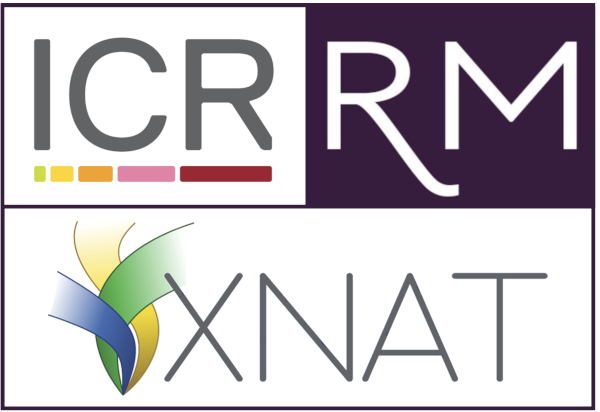Our technology: core XNAT functions
Imaging Research uses enormous quantities of data of very heterogeneous types. Whilst clinical scanners (CT, MRI, PET, Us, etc.) produce data that are stored in the well standardised DICOM format, research projects combine these with clinical, digital pathology and genomic data among others, each of which has its own format and analysis software. Core requirements for many studies are the provision of: (a) a common platform from which a canonical reference copy all the data may be accessed and (b) a harmonised workflow for data collection and archival.
XNAT [1] is a cross-platform, open-source tool, originally from the Neuroinformatics Research Group at Washington University, St Louis, and now supported and enhanced by the commercial company, Flywheel. XNAT is designed specifically to support imaging research. Its core function is to manage the import, archiving, processing, visualisation and secure distribution of image and related study data.
XNAT has a significant track record and is rapidly gaining traction in the imaging research community, with more than a decade of development already and an NIH programme funded till at least 2026. Since 2008, ICR has been developing the concept of a Research PACS [2] based on XNAT augmented by locally developed code, and XNAT was been selected as the primary technology for the CRUK National Cancer Imaging Translational Acclerator (NCITA) Image Repository. Starting in 2018, our work has been contributed back to the main XNAT project. In March 2021, a major milestone was reached with the release of a new version of the ICR-XNAT-OHIF viewer, a state-of-the-art zero-footprint, browser-based, PACS-like image viewer, with advanced AI abilities for image segmentation and annotation [3].
[1] Marcus, D.S., et al., The extensible neuroimaging archive toolkit. Neuroinformatics, 5(1), 11-33 (2007)
[2] Doran, S.J., et al., Development of a research PACS for functional imaging analysis in clinical research and clinical trials. Radiographics, 32, 2135-2150 (2012)
[3] Doran, Simon J. et al., Integrating the OHIF Viewer into XNAT: Achievements, Challenges and Prospects for Quantitative Imaging Studies, Tomography 8(1), 497-512 (2022); https://doi.org/10.3390/tomography8010040
Uploading data
XNAT supports a wide variety of methods to upload data, including: Importing DICOM image data and metadata directly from scanners; customizable forms for direct entry of clinical or psychometric data; and ZIP-enabled uploaders for archived data of all kinds.


Organizing and sharing your data
All data stored in XNAT is associated with a user-defined project. This association is the basis of the XNAT security model: users are given access to data on a project-by-project basis. You can set up a project that corresponds to your grant-approved study, or set up a “project” that represents a single site’s activity in a multi-site study. Or you can set up a project as a way of grouping together disparate but related data that exists in other projects. You are free to use any project organization scheme you choose.
View and downloading your data
XNAT also includes a zero-footprint, PACS-like image viewer that runs in a web browser. The XNAT team at ICR and NCITA have integrated the viewer tightly with the XNAT database and it can display not only radiology images but also digital pathology data, radiotherapy organ outlines, label maps and masks. Through our collaborative work with NVIDIA, the viewer supports AI workflows, for example automatic image segmentation. A dedicated measurement service makes it simple, for example, to use the XNAT viewer to run studies requiring RECIST tumour size measurements.


Securing and managing access to data
XNAT enables quality control procedures and provides secure ways for you to access your data and control its accessibility by your fellow researchers, and by the general public. Non-image data can be uploaded as a resource connected to your images, or entered into the the database itself as XML or through custom electronic case report forms (eCRF). XNAT subsequently maintains a history profile to track all changes made to the managed data.
User access to the archive is provided by a secure web application or a REST API. The web application provides a number of quality control and productivity features, including data entry forms, data-type-specific searches, searches that combine across data types, detailed reports, and listings of experimental data, upload/download tools, access to standard laboratory workflows, and administration and security tools.
Searching and explore large datasets
XNAT generates a web interface that allows you to store, retrieve, navigate and query data which corresponds to the data structures that are most important to your users. You can save search patterns, customise results, and share them with others so they can explore their own data in similar ways. In XNAT, it takes just 6 mouse clicks to drill down from the top-level of a multi-terabyte archive, consisting of hundreds of projects, to download a DICOM file. If you know the name of a particular data subject or imaging session, you can find it instantly via a flexible search box on the home page.


Run complex processing on your data, using high-powered computing
XNAT includes a powerful Container Service that allows for the programming of complex workflows with multiple levels of automation. And its secure API allows you to leverage high-powered computing clusters to perform these operations, saving time and bandwidth. Simply click on the relevant “run container” button to launch a compute job at the level of a single imaging sequence, a whole imaging session, a patient (or other data subject), or even a whole project for all subjects. You can also automate quality-control processes to ensure the validity of your data.
XNAT achieves all these things through a combination of a number of layers in the software architecture. The images themselves are stored on the filesystem of the instance host (often via a directory mounted from a specialised storage device). Metadata (i.e., information describing the context of the images, for example, when and where they were acquired, and exactly where the images are stored), including selected metadata from the DICOM files are stored in a PostgreSQL database. A sophistic web application, powered by middleware in a Java backend provides the graphical user interface.
XNAT is highly extensible and, since version 1.8.0, its design has specifically encouraged extensions to the platform’s functionality by allowing users to create plugins that add new behaviours and customisations.

